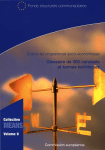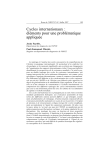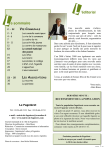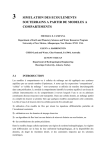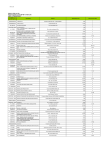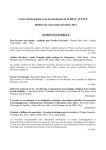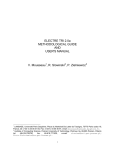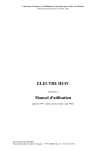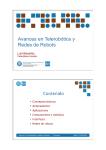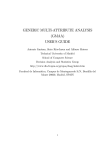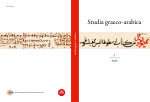Download Chapter 1 ELECTRE METHODS - Lamsade
Transcript
Chapter 1 ELECTRE METHODS José Figueira Faculdade de Economia and INESC-Coimbra Universidade de Coimbra Av. Dias da Silva, 165, 3004-512 Coimbra Portugal [email protected] Vincent Mousseau, Bernard Roy LAMSADE Université Paris-Dauphine Place du Maréchal De Lattre de Tassigny, 75775 Paris Cedex 16 France {mousseau,roy}@lamsade.dauphine.fr Abstract Over the last three decades a large body of research in the field of ELECTRE family methods appeared. This research has been conducted by several researchers mainly in Europe. The purpose of this chapter is to present a survey of the ELECTRE methods since their first appearance in mid-sixties, when ELECTRE I was proposed by Bernard Roy and his colleagues at SEMA consultancy company. The chapter is organized in five sections. The first section presents a brief history of ELECTRE methods. The second section is devoted to the main features of ELECTRE methods. The third section describes the different ELECTRE methods existing in the literature according to the three main problematics: choosing, ranking and sorting. The fourth section presents the recent developments and future issues on ELECTRE methods. Finally, the fifth section is devoted to the software and applications. An extensive and up-to-date bibliography is also provided in the end of this chapter. Keywords: Multiple criteria decision aiding, Outranking approaches, ELECTRE methods. 1 2 1. Introduction: A brief History How far back in history should we go to discover the origins of ELECTRE methods? Some years ago B. Roy and D. Vanderpooten [119] published an article (“The European School of MCDA: Emergence, Basic Features and Current Works”, Journal of Multi-Criteria Decision Analysis) on this very topic. This introduction is largely based on their paper, but additional material has been included to define the origins more precisely and to look more deeply into the history of ELECTRE methods. We have also benefited from an old, but nonetheless excellent, bibliography containing a lot of references collated by Y. Siskos, G. Wascher and H. Winkels [127]. The latter only covers the period 1966-1982, but contains many valuable references. The origins of ELECTRE methods go back to 1965 at the European consultancy company SEMA, which is still active today. At that time, a research team from SEMA worked on a concrete, multiple criteria, real-world problem regarding decisions dealing with the development of new activities in firms. For “solving” this problem a general multiple criteria method, MARSAN (Méthode d’Analyse, de Recherche, et de Sélection d’Activités Nouvelles) was built. The analysts used a weightedsum based technique included in the MARSAN method for the selection of the new activities [57]. When using the method the engineers from SEMA noticed serious drawbacks in the application of such a technique. B. Roy was thus consulted and soon tried to find a new method to overcome the limitations of MARSAN. The ELECTRE method for choosing the best action(s) from a given set of actions was thus devised in 1965, and was later referred to as ELECTRE I (electre one). In that same year (July, 1965) the new multiple criteria outranking method was presented for the first time at a conference (les journées d’études sur les méthodes de calcul dans les sciences de l’homme), in Rome (Italy). Nevertheless, the original ideas of ELECTRE methods were first merely published as a research report in 1966, the notorious Note de Travail 49 de la SEMA [10]. Shortly after its appearance, ELECTRE I was found to be successful when applied to a vast range of fields [18], but the method did not become widely known until 1968 when it was published in RIRO, la Revue d’Informatique et de Recherche Opérationnelle [89]. This article presents a comprehensive description of ELECTRE and the foundations of the outranking approach; the reader may also consult the graph theory book by B. Roy [90]. The method has since evolved and given rise to an “unofficial” version, ELECTRE Iv (electre one vee). This version took into account the notion of a veto threshold. A further version known as ELECTRE IS (electre one esse) appeared subsequently (see [117]) and ELECTRE Methods 3 was used for modelling situations in which the data was imperfect (see below). This is the current version of ELECTRE methods for choice problematic. The acronym ELECTRE stands for [10, 95]: ELimination Et Choix Traduisant la REalité (ELimination and Choice Expressing the REality), and was cited for commercial reasons. At the time it seemed adequate and served well to promote the new tool. Nevertheless, the developments in ELECTRE methods over the last three decades, the way in which we consider the tool today and the methodological foundations of multiple criteria decision aiding have made the meaning of the acronym unsatisfactory. An atypical ELECTRE method was also created to deal with the problem of highway layout in the Ile de France region; it was called the meaningful compensation method [11, 12, 25, 91, 109]. This approach was based on substitution rates. These rates were ill-defined (stakeholders views about their values strongly differed), it was only possible to fix a minimum and maximum value for each one. On such a basis a set of embedded fuzzy relations has been defined. In the late sixties, a different real-world decision making situation arose in media planning, concerning the definition of an advertising plan. For such a purpose the question was: how to establish an adequate system of ranking for periodicals (magazines, newspapers, ...)? This led to the birth of ELECTRE II (electre two): a method for dealing with the problem of ranking actions from the best option to the worst [1, 43, 106, 107]. However, in a world where perfect knowledge is rare, imperfect knowledge only could be taken into account in ELECTRE methods through the use of probabilistic distributions and expected utility criterion. Clearly more work needed to be done. Research in this area was still in its initial stages. Another way to cope with uncertain, imprecision and ill-determination has been introduced, the threshold approach [19, 49, 50, 114]. For more details and a comprehensive treatment of this issue see [14, 96, 97]. Just a few years later a new method for ranking actions was devised: ELECTRE III (electre three), [93, 116]. The main new ideas introduced by this method were the use of pseudo-criteria (see [92]) and fuzzy binary outranking relations. Another ELECTRE method, known as ELECTRE IV (electre four), arose from a new real-world problem related to the Paris subway network [38, 45, 110, 111, 113]. It now became possible to rank actions without using the relative criteria importance coefficients; this is the only ELECTRE method which does not make use of such coefficients. In addition, the new method was equipped with an embedded outranking relations framework. 4 Methods created up to this point were particularly designed to help decision making in choosing and ranking actions. However, in the late seventies a new technique of sorting actions into predefined and ordered categories was proposed i.e. the trichotomy procedure [67, 68, 94]. This is a decision tree based approach. Several years later, in order to help decision making in a large banking company which faced to the problem of accepting or refusing credits requested by firms, a specific method, ELECTRE A, was devised and applied in 10 sectors of activity. This should have remained confidential. The most recent sorting method, ELECTRE TRI (electre tree), was greatly inspired by these earlier works. It removed everything they had of specific given their context of application. Indeed, this new method is, at the same time, both simpler and more general [141, 142]. ELECTRE methods are still evolving. Section 4 presents recent developments on the topic and avenues for future research. 2. Main Features of ELECTRE Methods This section presents a set of key issues concerning ELECTRE methods: the context in which they are relevant, modelling with an outranking relation, their structure, the role of criteria, and how to account for imperfect knowledge. 2.1. In What Context Are ELECTRE Methods Relevant? ELECTRE methods are relevant when facing decision situations with the following characteristics (see, [99, 109, 122]). 1. The decision-maker (DM) wants to include in the model at least three criteria. However, aggregation procedures are more adapted in situations when decision models include more than five criteria (up to twelve or thirteen). And, at least one of the following situations must be verified. 2. Actions are evaluated (for at least one criterion) on an ordinal scale (see [84]) or on a weakly interval scale (see [63]). These scales are not suitable for the comparison of differences. Hence, it is difficult and/or artificial to define a coding that makes sense in terms of g (a)−g (b) preference differences of the ratios gjj (c)−gjj(d) , where gj (x) is the evaluation of action x on criterion gj . ELECTRE Methods 5 3. A strong heterogeneity related with the nature of evaluations exists among criteria (e.g., duration, noise, distance, security, cultural sites, monuments, ...). This makes it difficult to aggregate all the criteria in a unique and common scale. 4. Compensation of the loss on a given criterion by a gain on another one may not be acceptable for the DM. Therefore, such situations require the use of noncompensatory aggregation procedures (see Chapter ??). 5. For at least one criterion the following holds true: small differences of evaluations are not significant in terms of preferences, while the accumulation of several small differences may become significant. This requires the introduction of discrimination thresholds (indifference and preference) which leads to a preference structure with a comprehensive intransitive indifference binary relation (see Chapter ??). 2.2. Modelling Preferences Using an Outranking Relation Preferences in ELECTRE methods are modelled by using binary outranking relations, S, whose meaning is “at least as good as”. Considering two actions a and b, four situations may occur: aSb and not bSa, i.e., aP b (a is strictly preferred to b). bSa and not aSb, i.e., bP a (b is strictly preferred to a). aSb and bSa, i.e., aIb (a is indifferent to b). Not aSb and not bSa, i.e., aRb (a is incomparable to b). ELECTRE methods build one or several (crispy, fuzzy or embedded) outranking relations. Note that using outranking relations to model preferences introduces a new preference relation, R (incomparability). This relation is useful to account for situations in which the DM and/or the analyst are not able to compare two actions. The construction of an outranking relation is based on two major concepts: 1 Concordance. For an outranking aSb to be validated, a sufficient majority of criteria should be in favor of this assertion. 2 Non-discordance. When the concordance condition holds, none of the criteria in the minority should oppose too strongly to the assertion aSb. 6 These two conditions must be fulfilled for validating the assertion aSb. Given a binary relation on set A it is extremely helpful to build a graph G = (V, U ), where V is the set of vertices and U the set of arcs. For each action a ∈ A we associate a vertex i ∈ V and for each pair of actions (a, b) ∈ A the arc (i, l) exists either if aP b or aIb. An action a outranks b if and only if the arc (i, l) exists. If there is no arc between vertices i and l, it means that a and b are incomparable; if two reversal arcs exist, there is an indifference between both a and b. An outranking relation is not necessarily transitive. Preference intransitivities come from two different situations: Condorcet effect (see Chapter ??), and incomparabilities between actions. This requires an exploitation procedure to derive from such a relation results that fit the problematic (see Chapter ??). 2.3. Structure of ELECTRE Methods ELECTRE methods comprise two main procedures: construction of one or several outranking relation(s) followed by an exploitation procedure. The construction of one or several outranking relation(s) aims at comparing in a comprehensive way each pair of actions. The exploitation procedure is used to elaborate recommendations from the results obtained in the first phase. The nature of the recommendations depends on the problematic (choosing, ranking or sorting). Hence, each method is characterized by its construction and its exploitation procedures. For more details the reader may consult the following references: [70, 98, 99, 109, 135, 138]. 2.4. About the Relative Importance of Criteria The relative role attached to criteria in ELECTRE methods is defined by two distinct sets of parameters: the importance coefficients and the veto thresholds. The importance coefficients in ELECTRE methods refer to intrinsic “weights”. For a given criterion the weight, wj , reflects its voting power when it contributes to the majority which is in favor of an outranking. The weights do not depend neither on the ranges nor the encoding of the scales. Let us point out that these parameters can not be interpreted as substitution rates as in compensatory aggregation procedures AHP [120], MACBETH [7] and MAUT [55]. Veto thresholds express the power attributed to a given criterion to be against the assertion “a outranks b”, when the difference of the evaluation between g(b) and g(a) is greater than this threshold. These thresholds can be constant along a scale or it can also vary. ELECTRE Methods 7 A large quantity of works have been published on the topic of relative importance of criteria. The following list is not exhaustive: [35, 64, 69, 86, 87, 115, 116, 125, 136]. 2.5. Discrimination Thresholds To take into account the imperfect character of the evaluation of actions (see Chapter ??), ELECTRE methods make use of discrimination (indifference and preference) thresholds. This leads to a pseudo-criterion model on each criterion (see Chapter ??). Discrimination thresholds account for the imperfect nature of the evaluations, and are used for modelling situations in which the difference between evaluations associated with two different actions on a given criterion may either: justify the preference in favor of one of the two actions (preference threshold, pj ); be compatible with indifference between the two actions (indifference thresholds, qj ). be interpreted as an hesitation between opting for a preference or an indifference between the two actions. These thresholds can be constant or vary along the scale. When they are variable we must distinguish between direct (the evaluation of the best action is taken into account) and inverse (when they are computed by using the worst evaluation). How to assign values to such thresholds? There are several techniques which can be used, some of them come directly from the definition of threshold and other ask for the concept of dispersion threshold (see Section 4.2). A dispersion threshold allow us to take into account the concept of probable value and the notion of optimistic and pessimistic values. It translates the plausible difference, due to over or under-estimations, which affect the evaluation of a consequence or of a performance level. It should be noticed that there are no true values for thresholds. Therefore, the values chosen to assign to the thresholds are the most convenient (the best adapted) for expressing the imperfect character of the knowledge. For more details about thresholds see, [2, 17, 95, 100, 102, 103, 104, 109] 8 3. A Short Description of ELECTRE Methods A comprehensive treatment of ELECTRE methods may be found in the books by B. Roy and D. Bouyssou [109] and Ph. Vincke [139]. Much of the theory developed on this field is presented in these books. This theory, however, was foreshadowed in earlier papers namely by B. Roy and his colleagues at SEMA and later at LAMSADE (some of these papers were cited in the introduction). The books [64, 95, 100, 122, 123] are also good references in the area. ELECTRE software manuals also contain much material both on theoretical and pedagogical issues [2, 43, 75, 117, 134, 142]. Finally, several other works deserve to be mentioned because they include information concerning ELECTRE methods: [5, 15, 16, 20, 37, 52, 79, 87, 125]. In what follows we will only summarize the elementary concepts underlying ELECTRE methods; details will be omitted. More sophisticated presentations can, however, be found in the references cited above. Description of methods is presented in problematic and chronological order. 3.1. Choice Problematic Let us remind the purpose of choice problematic before presenting methods. The objective of this problematic consists of aiding DMs in selecting a subset of actions, as small as possible, in such a way that a single action may finally be chosen. The order in which methods will be presented permit us to understand the historical introduction of the two fundamental concepts in multiple criteria decision aiding, veto thresholds and pseudo-criteria. 3.1.1 ELECTRE I. The purpose underlying the description of this method is rather theoretical and pedagogical. The method does not have a significant practical interest, given the very nature of realworld applications, having usually a vast spectrum of quantitative and qualitative elementary consequences, leading to the construction of a contradictory and very heterogeneous set of criteria with both numerical and ordinal scales associated with them. In addition, a certain degree of imprecision, uncertainty or ill-determination is always attached to the knowledge collected from real-world problems. The method is very simple and it should be applied only when all the criteria have been coded in numerical scales with identical ranges. In such a situation we can assert that an action “a outranks b” (that is, “a is at least as good as b”) denoted by aSb, only when two conditions hold. 9 ELECTRE Methods On the one hand, the strength of the concordant coalition must be powerful enough to support the above assertion. By strength of the concordant coalition, we mean the sum of the weights associated to the criteria forming that coalition. It can be defined by the following concordance index (assuming, for the sake of formulae simplicity, that P w = 1, where J is the set of the indices of the criteria): j j∈J c(aSb) = X wj {j : gj (a)≥gj (b)} (where {j : gj (a) ≥ gj (b)} is the set of indices for all the criteria belonging to the concordant coalition with the outranking relation aSb.) In other words, the value of the concordance index must be greater than or equal to a given concordance level, s, whose value generally falls within the range [0.5, 1 − minj∈J wj ], i.e., c(aSb) ≥ s. On the other hand, no discordance against the assertion “a is at least as good as b” may occur. The discordance is measured by a discordance level defined as follows: d(aSb) = max {j : gj (a)<gj (b)} n o gj (b) − gj (a) This level measures in some way the power of the discordant coalition, meaning that if its value surpasses a given level, v, the assertion is no longer valid. Discordant coalition exerts no power whenever d(aSb) ≤ v. Both concordance and discordance indices have to be computed for every pair of actions (a, b) in the set A, where a 6= b. It is easy to see that such a computing procedure leads to a binary relation in comprehensive terms (taking into account the whole set of criteria) on the set A. Hence for each pair of actions (a, b), only one of the following situations may occur: aSb and not bSa, i.e., aP b (a is strictly preferred to b). bSa and not aSb, i.e., bP a (b is strictly preferred to a). aSb and bSa, i.e., aIb (a is indifferent to b). Not aSb and not bSa, i.e., aRb (a is incomparable to b). This preference-indifference framework with the possibility to resort to incomparability, says nothing about how to select the best compromise action, or a subset of actions the DM will focus his attention on. In the construction procedure of ELECTRE I method only one outranking relation S is matter of fact. 10 The second procedure consists of exploiting this outranking relation in order to identify a small as possible subset of actions, from which the best compromise action could be selected. Such a subset, Â, may be determined with the help of the graph kernel concept, KG . The justification of the use of this concept can be found in [109]. When the graph contains no direct cycles, there exists always a unique kernel; otherwise, the graph contains no kernels or several. But, let us point out that a graph G may contain direct cycles. If that is the case, a preprocessing step must take place where maximal direct cycles are reduced to singleton elements, forming thus a partition on A. Let Ā denote that partition. Each class on Ā = {Ā1 , Ā2 , . . .} is now composed of a set of (considered) equivalent actions. It should be noticed that a new preference relation, ≻, is defined on Ā: Āp ≻ Āq ⇔ ∃a ∈ Āp and ∃b ∈ Āq such that aSb for Āp 6= Āq In ELECTRE I all the actions which form a cycle are considered indifferent, which may be, criticized. ELECTRE IS was designed to mitigate this inconvenient (see Section 3.1.3). 3.1.2 ELECTRE Iv. The name ELECTRE Iv was an unofficial name created for designating ELECTRE I with veto threshold ([64]). This method is equipped with a different but extremely useful tool. The new tool made possible for analysts and DMs to overcome the difficulties related to the heterogeneity of scales. Whichever the scales type, this method is always able to select the best compromise action or a subset of actions to be analyzed by DMs. The new tool introduced was the veto threshold, vj , that can be attributed to certain criteria gj belonging to the family of criteria F . The concept of veto threshold is related in some way, to the definition of an upper bound beyond which the discordance about the assertion “a outranks b” can not surpass and allow an outranking. In practice, the idea of threshold is, however, quite different from the idea of the disconcordance level like in ELECTRE I. Indeed, while discordance level is related to the scale of criterion gj in absolute terms for an action a from A, threshold veto is related to the preference differences between gj (a) and gj (b). In terms of structure and formulae, little changes occur when moving from ELECTRE I to ELECTRE Iv. The only difference being the discordance condition, now called no veto condition, which may be stated as follows: gj (a) + vj (gj (a)) ≥ gj (b), ∀ j ∈ J 11 ELECTRE Methods To validate the assertion “a outranks b” it is necessary that, among the minority of criteria that are opposed to this assertion, none of them puts its veto. ELECTRE Iv uses the same exploitation procedure as ELECTRE I. But, this method is by no means complete; the problem of imperfect knowledge remains. 3.1.3 ELECTRE IS. How general an ELECTRE method can be when applied to choice decision-making problems? Is it possible to take into account simultaneously the heterogeneity of criteria scales, and imperfect knowledge about real-world decision-making situations? Previous theoretical research done on thresholds and semi-orders may, however, illuminate the issue of inaccurate data and permit to build a more general procedure, the so-called ELECTRE IS method. The main novelty of ELECTRE IS is the use of pseudo-criteria instead of true-criteria. This method is an extension of the previous one aiming at taking into account a double objective: primarily the use of possible no nil indifference and preference thresholds for certain criteria belonging to F and, correlatively, a backing up (reinforcement) of the veto effect when the importance of the concordant coalition decreases. Both concordance and no veto conditions change. Let us present separately the formulae for each one of theses conditions. • Concordance condition Let us start by building the following two indices sets: 1 concerning the coalition of criteria in which aSb n o J S = j ∈ J : gj (a) + qj (gj (a)) ≥ gj (b) 2 concerning the coalition of criteria in which bQa n J Q = j ∈ J : gj (a)+qj (gj (a)) < gj (a) ≤ gj (b)+pj (gj (b)) o The concordance condition will be: c(aSb) = X j∈J S wj + X ϕ j wj ≥ s j∈J Q where, ϕj = gj (a) + pj (gj (a)) − gj (b) pj (gj (a)) − qj (gj (a)) the coefficient ϕj decreases linearly from 1 to 0, when gj describes the range [gj (a) + qj (gj (a)), gj (a) + pj (gj (a))]. 12 • no veto condition The no veto condition can be stated as follows: gj (a) + vj (gj (a)) ≥ gj (b) + qj (gj (b))ηj where, ηj = 1 − c(aSb) − wj 1 − s − wj In the exploitation procedure, actions belonging to a cycle are no longer considered as indifferent as in the previous versions of ELECTRE for choice problems. Now, we take into account the concept of degree of robustness of “a outranks b”. It is a reinforcement of veto effect and allow us to build true classes of ex æquo (ties) and thus define an acycle graph over these classes. In such conditions there is always a single kernel. 3.2. Ranking Problematic In ranking problematic we are concerned with the ranking of all the actions belonging to a given set of actions from the best to the worst, possibly with ex æquo. There are three different ELECTRE methods to deal with this problematic. 3.2.1 ELECTRE II. From an historical and pedagogical point of view it is interesting to present ELECTRE II. This method was the first of ELECTRE methods especially designed to deal with ranking problems. Without going into further detail, it is important to point out that ELECTRE II was also the first method, to use a technique based on the construction of an embedded outranking relations sequence. The construction procedure is very closed to ELECTRE Iv, in the sense that it is also a true-criteria based procedure. Hence, it is not surprising that the no veto condition remains the same. However, concordance condition is modified in order to take into account the notion of embedded outranking relations. There are two embedded relations: a strong outranking relation followed by a weak outranking relation. Both the strong and weak relations are built thanks to the definition of two concordance levels, s1 > s2 , where s1 , s2 ∈ [0.5, 1 − minj∈J wj ]. Now, the concordance condition with the assertion “a outranks b” can be defined as follows: c(aSb) ≥ sr and c(aSb) ≥ c(bSa), for r = 1, 2 The exploiting procedure is a four-step algorithm: ELECTRE Methods 13 1 Partioning the set A. First, let us consider the relation S 1 over A. In a similar way like in ELECTRE I, this relation may define on A one or several cycles. If all the actions belonging to each maximal cycle are grouped together into a single class, a partition on A will be obtained. Let Ā denote this partition. When each class of Ā is not a singleton, the actions belonging to that class will be considered as ex æquo. For the purpose of comparison between elements of Ā a preference relation ≻1 will be used. This relation has the same meaning as the relation ≻ for ELECTRE I. 2 Building a complete pre-order Z1 on Ā. After obtaining Ā, the procedure identifies a subset B 1 of classes of Ā following the rule “no other is preferred to them” according to the relation ≻1 . After removing B 1 from Ā and applying the same rule to Ā\B 1 , a subset B 2 will be found. The procedure iterates in the same way till define the final partition on Ā, {B 1 , B 2 , . . .}. Now, on the basis of S 1 , we may define a rough version of the complete pre-order Z1 , while placing in the head of this pre-order and in an ex æquo position all classes of B 1 , then those of B 2 and so forth. In order to define Z1 in a more accurate way, we examine if it is possible to refine this pre-order on the basis of the relation S 2 . This refinement consists of using the information that brings this less believable outranking to decide between the various classes of a subset B p when it contains several classes. This refinement of the rough version is obtained while using S 2 to define over B p a complete pre-order that takes place between B p−1 and B p+1 . 3 Determining a complete pre-order Z2 on Ā. The procedure to obtain this pre-order is quite similar to the above one; only two modifications are needed: • apply the rule “they are not preferred to any other” instead ′ ′ of “no other is preferred to them”; let {B 1 , B 2 , . . .} denote the partition thus obtained; • define the rough version of the complete pre-order Z2 by putting it in the queue of this pre-order, and in an ex æquo ′ ′ position all classes of B 1 , then those of B 2 and so forth. 4 Defining the partial pre-order Z. The partial pre-order Z is an intersection of Z1 and Z2 , Z = Z1 ∩ Z2 , and it is defined in the following way: aZb ⇔ aZ1 b and aZ2 b. 14 3.2.2 ELECTRE III. ELECTRE III was designed to improve ELECTRE II and thus deal with inaccurate, imprecise, uncertain or illdetermination of data. This purpose was actually achieved, and ELECTRE III was applied with success during the last two decades on a broad range of real-life applications. In the current description of ELECTRE III we will omit several formulae details. The novelty of this method is the introduction of pseudocriteria instead of true-criteria. In ELECTRE III the outranking relation can be interpreted as a fuzzy relation. The construction of this relation requires the definition of a credibility index, which characterizes the credibility of the assertion “a outranks b”, aSb; let ρ(aSb) denote this index. It is defined by using both the concordance index (as determined in ELECTRE IS), c(aSb), and a discordance index for each criterion gj in F , that is, dj (aSb). The discordance of a criterion gj aims at taking into account the fact that this criterion is more or less discordant with the assertion aSb. The discordance index reaches its maximal value when criterion gj puts its veto to the outranking relation; it is minimal when the criterion gj is not discordant with that relation. To define the value of the discordance index on the intermediate zone, we simply admitted that this value grows in proportion to the difference gj (b) − gj (a). This index can now be presented as follows: dj (aSb) = 1 if gj (b) > gj (a) + vj (gj (a)) 0 if gj (b) ≤ gj (a) + pj (gj (a)) gj (b)−gj (a)−pj (gj (a)) vj (gj (a))−pj (gj (a)) , otherwise The credibility index is defined as follows, ρ(aSb) = c(aSb) {j∈J : dj 1 − dj (aSb) 1 − c(aSb) (aSb)>c(aSb)} Y Notice that, when dj (aSb) = 1, it implies that ρ(aSb) = 0, since c(aSb) < 1. The definition of ρ(aSb) is thus based on the following main ideas: a) When there is no discordant criterion, the credibility of the outranking relation is equal to the comprehensive concordance index. b) When a discordant criterion activates its veto power, the assertion is not credible at all, thus the index is null. ELECTRE Methods 15 c) For the remaining situations in which the comprehensive concordance index is strictly lower than the discordance index on the discordant criterion, the credibility index becomes lower than the comprehensive concordance index, because of the opposition effect on this criterion The index ρ(aSb) corresponds to the index c(aSb) weakened by possible veto effects. In [71] a modification of the valued outranking relation used in the ELECTRE III and ELECTRE TRI was proposed. The modification requires the implementation of the discordance concept. Such a modification is shown to preserve the original discordance concept; the new outranking relation makes it easier to solve inference programs. The exploitation procedure starts by deriving from the fuzzy relation two complete pre-orders as in ELECTRE II. A final partial pre-order Z is then built as the intersection of the two complete pre-orders, Z1 and Z2 , which are obtained according to two variants of the same principle, both acting in an antagonistic way on the floating actions. The partial pre-order Z1 is defined as a partition on the set A into q ordered classes, B̄1 , . . . , B̄h , . . . , B̄q , where B̄1 is the head-class in Z1 . Each class B̄h is composed of ex æquo elements according to Z1 . The complete pre-order Z2 is determined in a similar way, where A is partitioned into u ordered classes, B1 , . . . , Bh , . . . , Bu , Bu being the head-class. Each one of these ¯ ¯ ¯ ¯ classes is obtained as a final distilled of a distillation procedure. The procedure designed to compute Z1 starts (first distillation) by defining an initial set D0 = A; it leads to the first final distilled B̄1 . After getting B̄h , in the distillation h + 1, the procedure sets D0 = A\(B̄1 ∪. . .∪ B̄h ). According to Z1 , the actions in class B̄h are, preferable to those of class B̄h+1 ; for this reason, distillations that lead to these classes will be called as descending (top-down). The procedure leading to Z2 is quite identic, but now the actions in B̄h+1 are preferred to those in class B̄h ; these distillations will be called ascending (bottom-up). The partial pre-order Z will be computed as the intersection of Z1 and Z2 . A complete pre-order is finally suggested taking into account the partial pre-orders and some additional considerations. The way the incomparabilities which remain in the pre-order are treated is nevertheless subject to criticism. 16 3.2.3 ELECTRE IV. In Section 2.4 we pointed out the difficulty to define the relative importance coefficients of criteria. However, in several circumstances we are not able, we do not want, or we do not know how to assign a value to those coefficients. It does not mean that we would be satisfied with the pre-order obtained, when applying ELECTRE III with the same value for all the coefficients wj . Another approach we could take would be determining a pre-order, which takes into account all the pre-orders obtained from the application of several combinations of the weights. Obviously, this situation will be unmanageable. ELECTRE IV is also a procedure based on the construction of a set of embedded outranking relations. There are five different relations, S 1 , . . . , S 5 . The S r+1 relation (r = 1, 2, 3, 4) accepts an outranking in a less credible circumstances than the relation S r . It means (while remaining on a merely ordinal basis) the assignment of a value ρr for the credibility index ρ(aSb) to the assertion aSb. The chosen values must be such that ρr > ρr+1 . Furthermore, the movement from one credibility value ρr to another ρr+1 must be perceived as a considerable loss. The ELECTRE IV exploiting procedure is the same as in ELECTRE III. 3.3. Sorting Problematic A set of categories must be a priori defined. The definition of a category is based on the fact that all potential actions which are assigned to it will be considered further in the same way. In sorting problematic, each action is considered independently from the others in order to determine the categories to which it seems justified to assign it, by means of comparisons to profiles (bounds, limits), norms or references. Results are expressed using the absolute notion of “assigned” or “not assigned” to a category, “similar” or “not similar” to a reference profile, “adequate” or “not adequate” to some norms. The sorting problematic refers thus to absolute judgements. It consists of assigning each action to one of the pre-defined categories which are defined by norms or typical elements of the categories. The assignment of an action a to a specific category does not influence the category, to which another action b should be assigned. 3.3.1 ELECTRE TRI. ELECTRE TRI is designed to assign a set of actions, objects or items to categories. In ELECTRE TRI categories are ordered; let us assume from the worst (C1 ) to the best (Ck ). Each category must be characterized by a lower and an upper profile. Let C = {C1 , . . . , Ch , . . . , Ck } denote the set of categories. The assignment of a given action a to a certain category Ch results from the comparison ELECTRE Methods 17 of a to the profiles defining the lower and upper limits of the categories; bh being the upper limit of category Ch and the lower limit of category Ch+1 , for all h = 1, . . . , k. For a given category limit, bh , this comparison rely on the credibility of the assertions aSbh and bh Sa. This credibility (index) is defined as in ELECTRE III. In what follows, we will assume, without any loss of generality, that preferences increase with the value on each criterion. After determining the credibility index, we should introduce a λcutting level of the fuzzy relation in order to obtain a crisp outranking relation. This level can be defined as the credibility index smallest value compatible with the assertion aSbh . Let ≻ denote the preference, I denote the indifference relation and R denote the incomparability binary relations. The action a and the profile bh may be related to each other as follows: a) aIbh iff aSbh and bh Sa b) a ≻ bh iff aSbh and not bh Sa c) bh ≻ a iff not aSbh and bh Sa d) aRbh iff not aSbh and not bh Sa The objective of the exploitation procedure is to exploit the above binary relations. The role of this exploitation is to propose an assignment. This assignment can be grounded on two well-known logics. 1 The conjunctive logic in which an action can be assigned to a category when its evaluation on each criterion is at least as good as the lower limit which has been defined on the criterion to be in this category. The action is hence assigned to the highest category fulfilling this condition. 2 The disjunctive logic in which an action can be assigned to a category, if it has, on at least one criterion, an evaluation at least as good as the lower limit which has been defined on the criterion to be in this category. The action is hence assigned to the highest category fulfilling this condition. With this disjunctive rule, the assignment of an action is generally higher than with the conjunctive rule. This is why the conjunctive rule is usually interpreted as pessimistic while the disjunctive rule is interpreted as optimistic. This interpretation (optimistic-pessimistic) can be permuted according to the semantic attached to the outranking relation. When no incomparability occurs in the comparison of an action a to the limits of categories, a is assigned to the same category by both the 18 optimistic and the pessimistic procedures. When a is assigned to different categories by the optimistic and pessimistic rules, a is incomparable to all “intermediate” limits within the highest and lowest assignment categories. ELECTRE TRI is a generalization of the two above mentioned rules. The generalization is the following, in the conjunctive rule: replace, in the condition “on each criterion” by “on a sufficient majority of criteria and in the absence of veto” in the disjunctive rule: replace, the condition “on at least one criterion” by “on a sufficient minority of criteria and in the absence of veto” The two procedures can be stated as follows, 1 Pessimistic rule. An action a will be assigned to the highest category Ch such that aSbh−1 . a) Compare a successively with br , r = k − 1, k − 2, . . . , 0. b) The limit bh is the first encountered profile such that aSbh . Assign a to category Ch+1 . 2 Optimistic rule. An action a will be assigned to the lowest category Ch such that bh ≻ a. a) Compare a successively with br , r = 1, 2, . . . , k − 1. b) The limit bh is the first encountered profile such that bh ≻ a. Assign a to category Ch . 4. Recent Developments and Future Issues Although, several decades past since the birth of the first ELECTRE method, research on ELECTRE family method stills active today. Some of the recent developments are shortly described in this Section. 4.1. Robustness Concerns When dealing with real-world decision problems, DMs and analysts are often facing with several sources of imperfect knowledge regarding the available data. This leads to the assignment of arbitrary values to certain “variables”. In addition, modelling activity frequently requires to choose between some technical options, introducing thus an additional source of arbitrariness to the problem. For these reasons, analysts hesitate ELECTRE Methods 19 when assigning values to the preference parameters (weights, thresholds, categories lower and upper limits, ...), and the technical parameters (discordance and concordance indices, λ−cutting level, ...) of ELECTRE methods. In practice, it is frequent to define a reference system built from the assignment of central values to these two types of parameters. Then, an exploitation procedure should be applied in order to obtain outputs which are used to elaborate recommendations. But, what about the meaningfulness of such recommendations? They strongly depend on the set of central values attributed to the parameters. Should the analyst analyze the influence of a variation of each parameter, considered separately, on the results? And, then enumerate those parameters which provoke a strong impact on the results when their values vary from the central positions. This is a frequent way to proceed in classical operations research methods and it is called sensitivity analysis [32, 53, 79, 82]. But, this kind of analyzes has rather a theoretical interest than a practical one. Analysts are most often interested in building recommendations which remain acceptable for a large range of the parameters values. Such recommendations should be elaborated from what we call the robust conclusions (Chapter ??, [101, 105, 109]). Definition 1 A conclusion, C r , is said to be robust with respect to a domain, Ω, of possible values for the preference and technical parameters, if there is no a particular set of parameters, ω̄ ∈ Ω, which clearly invalidates the conclusion C r . A robustness concern consists of all the possible ways that contribute to build synthetic recommendations based on the robust conclusions. Possible ways to deal with robustness concerns in ELECTRE methods are illustrated, for example, in [26, 27, 29, 109, 116], Chapters ??, ?? and ??. 4.2. Elicitation of Parameter Values Implementing ELECTRE methods requires to determine values (or intervals of variation) for the preference parameters. Definition 2 A preference elicitation process proceeds through an interaction between DMs and analysts in which DMs express information about their preferences within a specific aggregation procedure. It is possible to distinguish among direct and indirect elicitation techniques. 20 4.2.1 Direct Elicitation Techniques. In direct elicitation procedures DMs should provide information directly on the values of the preference parameters. A major drawback of such techniques is that it is difficult to understand the precise meaning of the assertions of the DMs. This is why ELECTRE methods are usually implemented by using indirect elicitation procedures. 4.2.2 Indirect Elicitation Techniques. Indirect elicitation techniques do not require from DMs to provide answers to questions related to the values of the preference parameters. On the contrary, these techniques proceeds indirectly by posing questions whose answers can be interpreted through the aggregation procedure. Such techniques make use of the disaggregation paradigm [51, 60]. For instance, DIVAPIME [70] and SRF [35] elicitation techniques make it possible to determine the vector of the relative importance coefficients from pairwise comparisons of fictitious actions or a relative importance ranking of criteria. Recent developments concerning elicitation techniques have been proposed for the ELECTRE TRI method. Inference procedures have been developed to elicit the parameters values from assignment examples, i.e., an assignment that is imposed by DMs on specific actions. It is possible to infer all the preference parameters simultaneously [74]; we will refer to such a case by complete inference. The induced mathematical programming model to be solved is, however, non-linear. Thus, its resolution is computationally difficult for real-world problems. In such cases, it is possible to infer a subset of parameters only (see Figure 1.1): Concordant coalition parameters: weights and λ−cutting level [72]; Discordance related parameters: veto thresholds [28]; Category limits [76]. 21 ELECTRE Methods ELECTRE TRI Inferring from examples Partial inference Inferring weights Figure 1.1. 5. Inferring veto Direct elicitation Complete inference Inferring category limits Inferring parameter values for ELECTRE TRI Software and Applications The implementation of ELECTRE methods in real-world decision problems involving DMs requires software packages. Some of them are widely used in large firms and universities, in particular ELECTRE IS, ELECTRE III-IV, ELECTRE TRI and IRIS. Among the software available at LAMSADE are (http://www.lamsade.dauphine.fr/english/ software.html): 1 ELECTRE IS is a generalization of ELECTRE I. It is an implementation of ELECTRE IS described in Section 3.1. This software runs on a IBM-compatible computer on Windows 98 and higher. 2 ELECTRE III-IV is a software which implements ELECTRE III and ELECTRE IV methods described in Section 3.2. It runs on Windows 3.1, 95, 98, 2000, Millennium and XP. 3 ELECTRE TRI is a multiple criteria decision aiding tool designed to deal with sorting problems. This software implements ELECTRE TRI method described in Section 3.3. The ELECTRE TRI software versions 2.x were developed with the C++ programming language and runs on Microsoft Windows 3.1, 95, 98, Me, 2000, XP and NT. This software integrates, ELECTRE TRI Assistant which enables the user to define the weights indirectly, i.e., fixing the model parameters by giving some assignment examples (corresponding to desired assignments or past decisions). The weights are thus inferred through a certain form of regression. Hence, ELECTRE TRI Assistant reduces the cognitive effort required from the DM to elicit the preference parameters. 22 4 IRIS. Interactive Robustness analysis and parameters’ Inference for multiple criteria Sorting problems. This DSS has been built to support the assignment of actions described by their evaluation on multiple criteria to a set of predefined ordered categories, using a variant of ELECTRE TRI. Rather than demanding precise values for the model’s parameters, IRIS allows to enter constraints on these values, namely assignment examples that it tries to restore. When the constraints are compatible with multiple assignments for the actions, IRIS infers parameter values and allows to draw robust conclusions by indicating the range of assignments (for each action) that do not contradict any constraint. If it is not possible to fulfill all of the constraints, IRIS tells the user where is the source of inconsistency. It was developed with Delphi Borland and runs on Windows 98, Me, 2000, NT and XP. 5 SFR was designed to determine the relative importance coefficients for ELECTRE family methods. It is based on a very simple procedure (the pack of cards technique created by J. Simos) and try to assess these coefficients by questioning the DM in an indirect way. It was developed with the Delphi Borland 3.0 and runs on Windows 98, Me, 2000 and XP. The software ELECTRE IS, III-IV, TRI and TRI Assistant were developed under a collaborative project between researchers from the Institute of Computing Science of the Technical University of Poznan (Poland) and LAMSADE, Université Paris-Dauphine (France), while IRIS and SRF result from a collaborative project between researchers from LAMSADE and the Faculty of Economics of the University of Coimbra / INESC-Coimbra (Portugal). ELECTRE methods were successful applied in many areas. 1 Agriculture and Forest Management: [4, 31, 62, 118, 128, 130, 131] 2 Energy: [8, 9, 19, 39, 40, 54, 108, 126] 3 Environment and Water Management: [12, 40, 41, 44, 59, 78, 80, 85, 86, 118, 121, 124, 125, 131, 132, 77, 88, 58] 4 Finance: [3, 30, 46, 47, 48, 56, 61, 143, 144, 145, 146] 5 Military: [6, 36, 140] 6 Project selection (call for tenders): [13, 21, 24, 65, 107, 137]. 7 Transportation: [11, 12, 23, 38, 45, 73, 111, 112, 110, 114, 116] 8 Varia: [33, 34, 81, 83, 129, 107]. Acknowledgements 6. 23 Conclusion Since their first appearance, in 1965 (see [10]), ELECTRE methods, on one side, had a strong impact on the Operational Research community, mainly in Europe, and provoked the development of other outranking methods (see, for example, Chapters ?? and ??), as well as other complementary multiple criteria methodologies (see, for example, Chapters ?? and ??). Most importantly, the development of ELECTRE methods is strongly connected with the birth of the European Working Group of Multiple Criteria Decision Aiding (www.inescc.pt/ ∼ewgmcda/). On the other side, ELECTRE methods experienced a widespread and large use in real-world situations. Despite their almost four decades of existence, research stills active in this field. We can also mention some of recent developments and avenues for future research: generalization of the concordance and nondiscordance methods [133]; robustness analysis [26, 27, 29]; parameters elicitation techniques [74]; interaction between criteria [66, 42], multiple DMs and social interaction [22]. Acknowledgments This work has benefited from the Luso-French grant no 500B4 (ICCTI/ Ambassade de France au Portugal). The first author was also supported by the grant SFRH/BDP/6800/2001 (Fundação para a Ciência e Tecnologia, Portugal) and gratefully acknowledges DIMACS Research Center at Rutgers University for the welcome during his sabbatical leave (August 2002 - May 2003). The authors are thankful to Dominique Champ-Brunet for the many valuable references she provided. References [1] R. Abgueguen. La Sélection des Supports de Presse. Robert Lafont, Paris, 1971. [2] A. Aı̈t Younes, R. Azibi, and B. Roy. ELECTRE IS : Manuel d’utilisation. Document du LAMSADE 118 and 118bis, Université Paris-Dauphine, 2000. [3] A. Andenmatten. Evaluation du Risque de Défaillance des Emetteurs d’Obligations, Une Approche par l’Aide Multicritère à la Décision. Presses Polytechniques et Universitaires Romandes, Lausanne, Suisse, 1995. [4] C. Arondel and P. Girardin. Sorting cropping systems on the basis of their impact on groundwater quality. European Journal of Operational Research, 127:467–482, 2000. [5] C. Bana e Costa, editor. Readings in Multiple Criteria Decision Aid. Springer Verlag, Heidelberg, 1990. [6] C. Bana e Costa and C. Dinis das Neves. Describing and formalizing the evaluation process of Portuguese navy officiers. In A. Lockett and G. Islei, editors, Improving Decision Making in Organisations, volume 335 of Lecture Notes in Economics and Mathematical Systems, pages 355–369. Springer Verlag, Berlin, 1989. [7] C. Bana e Costa and J. Vansnick. MACBETH – An interactive path towards the construction of cardinal value functions. International Transactions in Operational Research, 1:489–500, 1994. [8] O. Barda, J. Dupuis, and P. Lencioni. Multicriteria location of thermal power plants. European Journal of Operational Research, 45:332–346, 1990. [9] M. Beccali, M. Cellura, and D. Ardente. Decision making in energy planning: The ELECTRE multicriteria analysis approach compared to a fuzzysets methodology. Energy Conversion and Management, 39 (16-18):1869–1881, 1998. [10] R. Benayoun, B. Roy, and B. Sussman. ELECTRE : Une méthode pour guider le choix en présence de points de vue multiples. Note de travail 49, SEMAMETRA International, Direction Scientifique, 1966. [11] P. Bertier, G. Gagey, J. de Montgolfier, and B. Roy. Choix de tracés autoroutiers en milieu suburbain : Faut-il vraiment endommager des sites urbains et/ou forestiers, lesquels ? Communication aux journées de formation “transports et agglomérations”, Nice, 1972. 25 26 [12] Y. Bétolaud and R. Février. Conservation des forêts suburbaines et passage des autoroutes. Revue Forestière Française, pages 197–200, 1973. [13] P. Blondeau, M. Spérandio, and F. Allard. Multicriteria analysis of ventilation in summer period. Building and Environment, 37 (2):165–176, 2002. [14] D. Bouyssou. Modelling inaccurate determination, uncertainty, imprecision using multiple criteria. In A. Lockett and G. Islei, editors, Improving Decision Making in Organisations, volume 335 of Lecture Notes in Economics and Mathematical Systems, pages 78–87. Springer Verlag, Berlin, 1989. [15] D. Bouyssou, E. Jacquet-Lagrèze, P. Perny, R. Slowinski, D. Vanderpooten, and Ph. Vincke, editors. Aiding Decisions with Multiple Criteria: Essays in Honour of Bernard Roy. Kluwer Academic Publishers, Dordrecht, 2001. [16] D. Bouyssou, T. Marchant, M. Pirlot, P. Perny, A. Tsoukiàs, and Ph. Vincke. Evaluation and Decision Model. A Critical Perspective. Kluwer Academic Publishers, Dordrecht, 2000. [17] D. Bouyssou and B. Roy. La notion de seuils de discrimination en analyse multicritère. INFOR, 25(4):302–313, 1987. [18] P. Buffet, J. Grémy, M. Marc, and B Sussmann. Peut-on choisir en tenant compte de critères multiples ? Une méthode ELECTRE et trois applications. Revue METRA, VI:283–316, 1967. [19] A. Charpentier and E. Jacquet-Lagrèze. La promotion de l’électricité dans l’entreprise et l’utilisation des méthodes multicritères. In H. Thiriez and S. Zionts, editors, Multiple Criteria Decision Making, volume 130 of Lecture Notes in Economics and Mathematical Systems, pages 364–377. Springer Verlag, Berlin, 1976. [20] A. Colorni, M. Paruccini, and B. Roy, editors. A-MCD-A – Aide Multi-Critère à la Décision – Multiple Criteria Decision Aiding. The European Commission Joint Research Center, Luxemburg, 2001. [21] G. Colson. The OR’s prize winner and the software ARGOS: How a multijudge and multicriteria ranking GDSS helps a jury to attribute a scientific award. Computers & Operations Research, 27 (7-8):741–755, 2000. [22] S. Damart. Aide à la décision et processus de décision collectifs : La contribution des outils d’aide à la décision aux démarches de concertation. PhD thesis, Université Paris-Dauphine, Paris, 2003. [23] S. Damart, V. Mousseau, and I. Sommerlatt. Du mode d’implication d’acteurs multiples dans le cadre de l’utilisation d’un modèle d’affectation multicritère : Analyse au regard d’une application à la tarification des transports publics. INFOR, 40(3):199–222, 2002. [24] N. Danila. Méthodologie d’aide à la décision dans le cas d’investissements fort dépendants. PhD thesis, Université Paris-Dauphine, 1980. [25] J. de Montgolfier and P. Bertier. Approche Multicritère des Problèmes de Décision. Editions Hommes et Techniques, Paris, 1978. References 27 [26] L. Dias and J. Clı́maco. On computing ELECTRE’s credibility indices under partial information. Journal of Multi-Criteria Decision Analysis, 8(2):74–92, 1999. [27] L. Dias and J. Clı́maco. ELECTRE TRI for groups with imprecise information on parameter values. Group Decision and Negotiation, 9(5):355–377, 2000. [28] L. Dias and V. Mousseau. Inferring ELECTRE’s veto-related parameters from outranking examples. European Journal of Operational Research, to appear, 2004. [29] L. Dias, V. Mousseau, J. Figueira, and J. Clı́maco. An aggregation/disaggregation approach to obtain robust conclusions with ELECTRE TRI. European Journal of Operational Research, 138:332–348, 2002. [30] A.I. Dimitras, C. Zopounidis, and C. Hurson. Assessing financial risks using a multicriteria sorting procedure: The case of country risk asessment. Foundations of Computing and Decision Sciences, 29:97–109, 2001. [31] L. Duckstein and M. Gershon. Multicriterion analysis of a vegetation management problem using ELECTRE II. Applied Mathematical Modelling, 7 (4):254– 261, 1983. [32] J. Evans. Sensitivity analysis in decision theory. Decision Sciences, 15:239–247, 1984. [33] D. Ferrand and J. Martel. Le choix multicritère des items d’une échelle de mesure. Mathématiques et Sciences Humaines, 89:35–59, 1985. [34] J. Fichefet and J. Leclercq. A multicriteria microcomputer-assisted system for the identification of bacteria. European Journal of Operational Research, 24:12–22, 1986. [35] J. Figueira and B. Roy. Determining the weights of criteria in the ELECTRE type methods with a revised Simos’ procedure. European Journal of Operational Research, 139:317–326, 2002. [36] V. Gabrel. Méthodologie pour la planification de production de système d’observation de la terre par satellites : Aspects algorithmiques et multicritères. PhD thesis, Université Paris-Dauphine, 1994. [37] T. Gal, T. Stewart, and T. Hanne, editors. Advances in MultCriteria Decision Making – MCDM Models, Algorithms, Theory, and Applications. Kluwer Academic Publishers, Boston, 1999. [38] L. Gargaillo. Réponse à l’article “Le plan d’extension du métro en banlieue parisienne, un cas type de l’analyse multicritère”. Les Cahiers Scientifiques de la Revue Transports, 7:52–57, 1982. [39] E. Georgopoulou, D. Lalas, and L. Papagiannakis. A multicriteria decision aid approach for energy planning problems: The case of renewable energy option. European Journal of Operational Research, 103 (1):38–54, 1997. [40] E. Georgopoulou, Y. Sarafidis, S. Mirasgedis, S. Zaimi, and D. Lalas. A multiple criteria decision-aid approach in defining national priorities for greenhouse 28 gases emissions reduction in the energy sector. European Journal of Operational Research, 146:199–215, 2003. [41] M. Gershon, L. Duckstein, and R. McAniff. Multiobjective river basin planning with qualitative criteria. Water Resources Research, 18:193–202, 1982. [42] S. Greco and J. Figueira. Dealing with interaction between bi-polar multiple criteria preferences in outranking methods. Research Report 11-2003, INESCCoimbra, Portugal, 2003. [43] J. Grolleau and J. Tergny. Manuel de référence du programme ELECTRE II. Document de travail 24, SEMA-METRA International, Direction Scientifique, 1971. [44] J. Hokkanen and P. Salminen. Choosing a solid waste management system using multicriteria decision analysis. European Journal of Operational Research, 98 (1):19–36, 1997. [45] J. Hugonnard and B. Roy. Le plan d’extension du métro en banlieue parisienne, un cas type d’application de l’analyse multicritère. Les Cahiers Scientifiques de la Revue Transports, 6:77–108, 1982. [46] C. Hurson and C. Zopounidis. On the use of multicriteria decision aid methods to portfolio selection. The Journal of Euro-Asian Management, 1(2):69–94, 1995. [47] C. Hurson and C Zopounidis. Gestion de Portefeuille et Analyse Multicritère. Economica, Paris, 1997. [48] C. Hurson and C. Zopounidis. On the use of multicriteria decision aid methods to portfolio selection. In J. Clı́maco, editor, Multicriteria Analysis, pages 496– 507. Springer Verlag, Berlin, 1997. [49] E. Jacquet-Lagrèze. Le problème de l’agrégation des préférences : Une classe de procédures à seuil. Mathématiques et Sciences Humaines, 43:29–37, 1973. [50] E. Jacquet-Lagrèze. How we can use the notion of semi-orders to build outranking relations in multicriteria decision making. In E. Wendt and C. Vleck, editors, Utility, Subjective Probability and Human Decision Making, pages 87– 112. Reidel, Dordrecht, 1975. [51] E. Jacquet-Lagrèze and Y. Siskos. Assessing a set of additive utility functions for multicriteria decision making: The UTA method. European Journal of Operational Research, 10:151–164, 1982. [52] E. Jacquet-Lagrèze and Y. Siskos, editors. Méthode de Décision Multicritère. Editions Hommes et Techniques, Paris, 1983. [53] R. Kampke. Sensitivity analysis for assessing preferentially independent order relations. Computers & Operations Research, 23(12):1119–1130, 1996. [54] A. Karagiannidis and N. Moussiopoulos. Application of ELECTRE III for the integrated management of municipal solid wastes in the greater Athens area. European Journal of Operational Research, 97 (3):439–449, 1997. [55] R. Keeney and H. Raiffa. Decisions with Multiple Objectives: Preferences and Value Tradeoffs. John Wiley & Sons, New York, 1976. References 29 [56] N. Khoury, J. Martel, and P. Yourougou. A multicriterion approach to country selection for global index founds. Document de travail FSA 91-13, Faculté des Sciences de l’Administration, Université Laval, Québec, Canada, 1991. [57] R. Laffy. La méthode MARSAN pour la recherche de produits nouveaux. Presented at the ESOMAR congress, Copenhagen, September 1966. [58] R. Lahdelma, P. Salminen, and J. Hokkanen. Locating a waste treatment facility by using stochastic multicriteria acceptability analysis with ordinal criteria. European Journal of Operational Research, 142:345–356, 2002. [59] M. Mahmoud and L. Garcia. Comparison of different multicriteria evaluation methods for the Red Bluff diversion dam. Environmental Modelling and Software, 15 (5):471–478, 2000. [60] J. March. Ambiguity and the engineering of choice. Bell Journal of Economics, 9:587–608, 1978. [61] J. Martel, N. Khoury, and M. Bergeron. An application of a multicriteria approach to portfolio comparisons. Journal of the Operational Research Society, 39:617–628, 1988. [62] J. Martel and A. Rousseau. Cadre de référence d’une démarche multicritère de gestion intégrée des ressources en milieu forestier. Document technique 93-11, Ministère de l’environment et de la faune, Québec, 1993. [63] J. Martel and B. Roy. Analyse de la signifiance de diverses procédures d’agrégation multicritère. Annales du LAMSADE 1, Université ParisDauphine, 2002. [64] L. Maystre, J. Pictet, and J. Simos. Les Méthodes Multicritères ELECTRE. Presses Polytechniques et Universitaires Romandes, Lausanne, 1994. [65] J. Michel. La sélection des projects du programme architecture nouvelle. In Actes du congrès Association Française pour la Cybernétique Economique et Technique (AFCET) : Aide à la Décision, Paris, May 16-17, 1974, pages 111– 121, 1974. [66] L. Montano-Guzmán. Fuzzy measures and integrals in the MCDA sorting problematic: Methodology and application to the diagnosis of firms. PhD thesis, Université Libre de Bruxelles, Brussels, Belgium, 2002. [67] J. Moscarola. Aide à la décision en présence de critères multiples fondée sur une procédure trichotomique : Méthodologie et application. Thèse de doctorat de 3e cycle, Université Paris V René Decartes, 1977. [68] J. Moscarola and B. Roy. Procédure automatique d’examen de dossiers fondée sur une segmentation trichotomique en présence de critères multiples. RAIRO Recherche Opérationnelle, 11(2):145–173, 1977. [69] V. Mousseau. Problèmes liés à l’évaluation de l’importance relative des critères en aide multicritère à la décision : Réflexions théoriques, expérimentations et implémentations informatiques. PhD thesis, Université Paris-Dauphine, 1993. 30 [70] V. Mousseau. Eliciting information concerning the relative importance of criteria. In P. Pardalos, Y. Siskos, and C. Zopounidis, editors, Advances in Multicriteria Analysis, Nonconvex Optimization and its Applications, pages 17–43. Kluwer Academic Publishers, Dordrecht, 1995. [71] V. Mousseau and L. Dias. Valued outranking relations in ELECTRE providing manageable disaggregation procedures. European Journal of Operational Research, in press, 2004. [72] V. Mousseau, J. Figueira, and J. Naux. Unsing assignment examples to infer weights for ELECTRE TRI method: Some experimental results. European Journal of Operational Research, 130(2):263–275, 2001. [73] V. Mousseau, B. Roy, and I. Sommerlatt. Elaboration d’un outil d’aide à la décision en vue de l’évolution de la tarification des transports publics en Ile de France. Journal of Decision Systems, 9(2):289–315, 2000. [74] V. Mousseau and R. Slowinski. Inferring an ELECTRE TRI model from assignment examples. Journal of Global Optimization, 12(2):157–174, 1998. [75] V. Mousseau, R. Slowinski, and P. Zielniewicz. ELECTRE TRI 2.0a: Methodological guide and user’s documentation. Document du LAMSADE 111, Université Paris-Dauphine, 1999. [76] A. Ngo The and V. Mousseau. Using assignment examples to infer category limits for the ELECTRE TRI method. Journal of Multi-Criteria Decision Analysis, 11(1):29–43, 2002. [77] M.F. Norese and S. Viale. A multi-profile sorting procedure in the public administration. European Journal of Operational Research, 138:365–379, 2002. [78] E. Parent and P. Schnabele. Le choix d’un aménagement aquacole : Exemple d’utilisation de la méthode ELECTRE III et comparaison avec d’autres méthodes multicritères d’aide à la décision. Cahier du LAMSADE 47, Université Paris-Dauphine, 1988. [79] J. Pomerol and S. Barba-Romero. Multicriterion Decision Making in Management. Kluwer Academic Publishers, Dordrecht, 2000. [80] K. Raju and C. Pillai. Multicriterion decision making in river basin planning and development. European Journal of Operational Research, 112 (2):249–257, 1999. [81] J. Richard. Aide à la décision stratégique en PME. In E. Jacquet-Lagrèze and Y. Siskos, editors, Méthode de décision multicritère, pages 119–143. Editions Hommes et Techniques, Paris, 1983. [82] D. Rios Insua and S. French. A framework for sensitivity analysis in discrete multi-objective decision making. European Journal of Operational Research, 54:176–190, 1991. [83] E. Roba, B. Sussmann, and M. Theys. Les Méthodes de Choix Multicritère Appliquées à la Sélection du Personnel: Models of Manpower. The English University Press, London, 1970. [84] F. Roberts. Measurement Theory, with Applications to Decision Making, Utility and the Social Sciences. Addison-Wesley, New York, 1979. References 31 [85] M. Rogers and M. Bruen. Choosing realistic values of indifference, preference and veto thresholds for use with environmental criteria within ELECTRE. European Journal of Operational Research, 107 (3):542–551, 1998. [86] M. Rogers and M. Bruen. A new system for weighting environmental criteria for use within ELECTRE III. European Journal of Operational Research, 107 (3):552–563, 1998. [87] M. Rogers, M. Bruen, and L. Maystre. ELECTRE and Decision Support. Kluwer Academic Publishers, London, 2000. [88] J. Rohmer and J. Veret. Choix d’une stratégie commerciale dans la distribution succursaliste. In E. Jacquet-Lagrèze and Y. Siskos, editors, Méthode de décision multicritère, pages 91–118. Editions Hommes et Techniques, Paris, 1983. [89] B. Roy. Classement et choix en présence de points de vue multiples (la méthode ELECTRE). RIRO, 8:57–75, 1968. [90] B. Roy. Algèbre Moderne et Théorie des Graphes Orientées vers les Sciences Economiques et Sociales. Dunod, Paris, 1969 (volume 1) 1970 (volume 2). [91] B. Roy. Critères multiples et modélisation des préférences : l’apport des relations de surclassement. Revue d’Économie Politique, 1:1–44, 1974. [92] B. Roy. From optimization to multicriteria decision aid: Three main operational attitudes. In H. Thiriez and S. Zionts, editors, Multiple Criteria Decision Making, volume 130 of Lecture Notes in Economics and Mathematical Systems, pages 1–34. Springer Verlag, Berlin, 1976. [93] B. Roy. ELECTRE III : Un algorithme de classements fondé sur une représentation floue des préférences en présence de critères multiples. Cahiers du CERO, 20(1):3–24, 1978. [94] B. Roy. A multicriteria analysis for trichotomic segmentation problems. In P. Nijkamp and J. Spronk, editors, Multiple Criteria Analysis: Operational Methods, pages 245–257. Gower Press, Farnborough, 1981. [95] B. Roy. Méthodologie Multicritère d’aide à la Décision. Economica, Paris, 1985. [96] B. Roy. Main sources of inaccurate determination, uncertainty and imprecision in decision models. In B. Munier and M. Shakun, editors, Compromise, Negotiation and Group Decision, pages 43–62. Reidel Publishing Company, Dordrecht, 1988. [97] B. Roy. Main sources of inaccurate determination, uncertainty and imprecision. Mathematical and Computer Modelling, 12(10/11):1245–1254, 1989. [98] B. Roy. The outranking approach and the foundations of ELECTRE methods. In C.A. Bana e Costa, editor, Readings in Multiple Criteria Decision Aid, pages 155–183. Springer-Verlag, Berlin, 1990. [99] B. Roy. The outranking approach and the foundations of ELECTRE methods. Theory and Decision, 31:49–73, 1991. [100] B. Roy. Multicriteria Methodology for Decision Aiding, volume 12 of Nonconvex Optimization and its Applications. Kluwer Academic Publishers, Dordrecht, 1996. 32 [101] B. Roy. A missing link in OR-AD: Robustness analysis. Foundations of Computing and Decision Sciences, 23(3):141–160, 1998. [102] B. Roy. Decision-aiding today: What should we expect? In T. Gal, T. Stewart, and T. Hanne, editors, Advances in MultCriteria Decision Making – MCDM Models, Algorithms, Theory, and Applications, pages 1.1–1.35. Kluwer Academic Publishers, Boston, 1999. [103] B. Roy. A French-English decision aiding glossary. In Newsletter of the EWG on MCDA (Supplement 1), volume Series 3(1). Faculty of Economics, INESCCoimbra, Portugal, 2000. [104] B. Roy. Optimisation et analyse multicritère. In C. Jessua, C. Labrousse, and D. Vitry, editors, Dictionnaire des Sciences Economiques, pages 640–643. Presses Universitaires de Frances, Paris, 2001. [105] B. Roy. Robustesse de quoi et vis-à-vis de quoi mais aussi robustesse pourquoi en aide à la décision ? In C. Henggeler-Antunes, J. Figueira, and J. Clı́maco, editors, Proceedings of the 56th Meeting of the European Working Group Multiple Criteria Decision Aiding, Coimbra, Portugal, 3-5 October 2002. Commissão de Coordenação da Região Centro, Coimbra, Portugal, to appear 2004. [106] B. Roy and P. Bertier. La méthode ELECTRE II. Note de travail 142, SEMAMETRA Metra International, 1971. [107] B. Roy and P. Bertier. La méthode ELECTRE II – Une application au médiaplanning. In M. Ross, editor, OR’72, pages 291–302. North-Holland Publishing Company, Amsterdam, 1973. [108] B. Roy and D. Bouyssou. Comparison of two decision-aid models applied to a nuclear plant siting example. European Journal of Operational Research, 25:200–215, 1986. [109] B. Roy and D. Bouyssou. Aide Multicritère à la Décision : Méthodes et Cas. Economica, Paris, 1993. [110] B. Roy and J. Hugonnard. Classement des prolongements de lignes de métro en banlieue parisienne (présentation d’une méthode multicritère originale). Cahiers du CERO, 24(2-3-4):153–171, 1982. [111] B. Roy and J. Hugonnard. Le plan d’extension du métro en banlieue parisienne, un cas type de l’analyse multicritère. Les Cahiers Scientifiques de la Revue Transports, 6:77–108, 1982. [112] B. Roy and J. Hugonnard. Ranking of suburban line extension projects on the Paris metro system by a multicriteria method. Transportation Research, 16A(4):301–312, 1982. [113] B. Roy and J. Hugonnard. Réponse à Monsieur Gargaillo. Les Cahiers Scientifiques de la Revue Transports, 7:58–64, 1982. [114] B. Roy, E. Jacquet-Lagrèze, and M. Blancher. Elaboration de critères permettant une intégration des divers aspects liés au temps dans l’aide à la décision en matière de transports. 1re phase 1975, 2e phase 1977, Délégation Générale à la Recherche Scientifique et Technique DGRST-SAEI, Action Thématique Programmée ATP Socio-Economie des Transports, 1977. References 33 [115] B. Roy and V. Mousseau. A theoretical framework for analysing the notion of relative importance of criteria. Journal of Multi-Criteria Decision Analysis, 5:145–159, 1996. [116] B. Roy, M. Présent, and D. Silhol. A programming method for determining which Paris metro stations should be renovated. European Journal of Operational Research, 24:318–334, 1986. [117] B. Roy and J. Skalka. ELECTRE IS : Aspects méthodologiques et guide d’utilisation. Document du LAMSADE 30, Université Paris Dauphine, 1984. [118] B. Roy, R. Slowinski, and W. Treichel. Multicriteria programming of water resources supply systems for rural areas. Water Resources Bulletin, 28 (1):13– 31, 1992. [119] B. Roy and D. Vanderpooten. The European school of MCDA: Emergence, basic features and current works. Journal of Multi-Criteria Decision Analysis, 5(1):22–37, 1996. [120] T. Saaty. The Analytical Hierarchy Process. McGraw-Hill, New York, 1980. [121] P. Salminen, J. Hokkanen, and R. Lahdelma. Comparing multicriteria methods in the context of environmental problems. European Journal of Operational Research, 104 (3):485–496, 1998. [122] A. Schärlig. Décider sur Plusieurs Critères, Panorama de l’Aide à la Décision Multicritère. Presses Polytechniques et Universitaires Romandes, Lausanne, 1985. [123] A. Schärlig. Pratiquer ELECTRE et PROMÉTHÉE : Un Complément à Décider sur Plusieurs Critères. Presses Polytechniques et Universitaires Romandes, Lausanne, 1996. [124] R. Silva Lopez. Une technique systématique de modélisation multicritère pour l’évaluation d’alternatives de lutte contre la pollution industrielle : Technologies propres ou curatives. Document du LAMSADE 60, Université ParisDauphine, 1990. [125] J. Simos. Gestion des Déchets Solides Urbains Genevois : Les Faits, le Traitement, l’Analyse. Presses Polytechniques et Universitaires Romandes, Lausanne, 1990. [126] Y. Siskos and Ph. Hubert. Multi-criteria analysis of the impacts of energy alternatives: A survey and a new comparative approach. European Journal of Operational Research, 13:278–299, 1983. [127] Y. Siskos, G. Wascher, and H. Winkels. A bibliography on outranking approaches (1966-1982). Cahier du LAMSADE 31, Université Paris Dauphine, 1983. [128] R. Srinivasa, L. Duckstein, and C. Arondel. Multicriterion analysis for sustainable water resources planning: A case study in Spain. Water Resources Management, 14:435–456, 2000. [129] Y. Tanguy and N. Leclere. Une application des méthodes de choix multicritères à l’étude de l’adéquation des personnels aux postes de travail. In 34 Actes du congrès Association Française pour la Cybernétique Economique et Technique (AFCET) : Aide à la Décision, Paris, May 16-17, 1974, pages 139– 147, 1974. [130] A. Tecle and L. Duckstein. A procedure for selecting MCDM techniques for forest resources management. In A. Goicoechea, L. Duckstein, and S. Zionts, editors, Multiple Criteria Decision Making and Support at the Interface of Industry, Business and Finance, pages 19–32. Springer Verlag, New York, 1992. [131] A. Tecle, M. Fogel, and L. Duckstein. Multicriterion analysis of forest watershed management alternatives. Water Resources Bulletin, 24:1169–1178, 1988. [132] J. Teng and G. Tzeng. Multicriteria evaluation for strategies of improving and controlling air quality in the super city: A case study of Taipei city. Journal of Environmental Management, 40 (3):213–229, 1994. [133] A. Tsoukiàs, P. Perny, and Ph. Vincke. From concordance/discordance to the modelling of positive and negative reasons in decision aiding. In D. Bouyssou, E. Jacquet-Lagrèze, P. Perny, R. Slowiński, D. Vanderpooten, and Ph. Vincke, editors, Aiding Decisions with Multiple Criteria: Essays in Honour of Bernard Roy, pages 147–174. Kluwer Academic Publishers, Dordrecht, 2002. [134] D. Vallée and P. Zielniewicz. ELECTRE III-IV, version 3.x, Aspects Méthodologiques (tome 1), Guide d’utilisation (tome 2). Document du LAMSADE 85 et 85bis, Université Paris Dauphine, 1994. [135] D. Vanderpooten. The construction of prescriptions in outranking methods. In C. Bana e Costa, editor, Readings in Multiple Criteria Decision Aid, pages 184–216. Springer Verlag, Heidelberg, 1990. [136] J. Vansnick. On the problem of weight in multiple criteria decision making (the non-compensatory approach). European Journal of Operational Research, 24:288–294, 1986. [137] M. Ventura. Evry 1 : Concours d’aménagement urbain. Cahier 31, Institut d’Amenagement et d’Urbanisme de la Région Parisienne (IAURP), Paris, 1973. [138] Ph. Vincke. Exploitation of a crisp relation in a ranking problem. Theory and Decision, 32(3):221–240, 1992. [139] Ph. Vincke. Multicriteria Decision-Aid. John Wiley & Sons, New York, 1992. [140] D. Wijnmalen. A case-study in military decision-making with mission-oriented multiple objectives. In J. Clı́maco, editor, Multicriteria Analysis, pages 549– 560. Springer Verlag, Berlin, 1997. [141] W. Yu. Aide multicritère à la décision dans le cadre de la problématique du tri : Concepts, méthodes et applications. PhD thesis, Université Paris-Dauphine, 1992. [142] W. Yu. ELECTRE TRI : Aspects méthodologiques et manuel d’utilisation. Document du LAMSADE 74, Université Paris-Dauphine, 1992. [143] C. Zopounidis. Evaluation du Risque de Défaillance de l’Entreprise : Méthodes et Cas d’Application. Economica, Paris, 1995. References 35 [144] C. Zopounidis. Operational Tools in the Management of Financial Risks. Kluwer Academic Publishers, Dordrecht, 1998. [145] C. Zopounidis and A Dimitras. Multicriteria Decision Aid Methods for the Prediction of Business Failure. Kluwer Academic Publishers, Dordrecht, 1998. [146] C. Zopounidis and C. Hurson. Portfolio selection and multicriteria analysis. In C. Floudas and P. Pardalos, editors, Encyclopedia of Optimization, Vol. IV, pages 310–322. Kluwer Academic Publishers, Dordrecht, 2001.




































